Vedas suggested ghee is the primary ingredient for performing yagna, which is done before initiating anything new in life or attaining happiness. Ghee to Agni(fire) is the primary substance of all Yagnas(Yagyas).
Ghee helps to stimulate the combustion of wood and keeps the fire burning for a long duration. However, By shastras, Agni is meant to be a mouth of the gods and using the medium of Agni, ghee is the food that is offered to god— hence here we are able to justify both the scientific and spiritual worth of ghee.
Pure desi ghee indicates the substance that offers longevity and an ideogram of purity, optimism, and nurturing. It is also meant as a desi ghee lamp that can attract the aura of Kubera and greets you with wealth, happiness, luxury, and power. There are a lot of benefits of burning cow ghee in Yagna.
Read more : Cow Ghee & its medicinal uses in Ayurveda
Health benefits of A2 cow ghee
1. Improves digestion
Ghee helps in promoting digestive strength by enhancing the secretion of enzymes. As it embraces lower chain fatty acids like butyric acid, it is quickly absorbed and metabolized.
Thus, people who are having digestion problems can be beneficial for the consumption of ghee because of their body’s increasing capacity to break down their food. Ghee also flushes out toxins from the body.
Constipation can be resolved by an intake of a dollop of ghee. Consuming a spoonful of ghee mixed in a cup of lukewarm milk before going to bed is a gentle but effective way of relieving constipation.
2. Builds strong bones
Ghee is enriched in vitamin K, especially vitamin K2, which is essential in aiding the body to minerals and calcium. This vitamin is even more important in building bones than calcium. And it may also protect against tooth decay if a moderate level is maintained.
Moreover, ghee promotes lubrication to joints and connective tissues by increasing flexibility. The regular intake of ghee builds immunity against infinite disorders while connecting body tissues.
It is also useful in the stimulation process of the sensory organs. Brain relates to memory, wisdom, and intellect also enhanced on account of the consumption of ghee.
3. Boosts heart health
Ghee is commonly helpful to control an increase in cholesterol levels. But ghee is a much safer cooking medium versus refined oils. The body directly utilizes the lower-chain fatty acids in ghee as an energy supplier without collecting them as fats and so they are not connected to heart disease like the long-chain fatty acids.
Ghee can maintain good cholesterol and decrease bad cholesterol. Furthermore, ghee contains omega-3 fatty acids, which are monounsaturated fats and are essential in maintaining good heart health since they diminish the risk of heart blockages, heart failure, and stroke.
The presence of vitamin K2 in ghee helps in reducing the overthrow of calcium in the arteries and therefore it protects the calcification of arteries.
4. Avoid Inflammation
With the presence of high amounts of healthy fats and fatty acids, ghee is also rich in butyrate, which has anti-inflammatory properties. With the help of this fatty acid, the body fights inflammation, especially in the gastrointestinal effect. Therefore, it will be very helpful for people with Crohn’s disease, ulcerative colitis, and related inflammatory bowel syndromes to include ghee in their meals.
5. Enhances energy levels
Experts suggest athletes for eating ghee as an ample source of energy, and possibly others should also follow the same fact. The liver significantly processes the fatty acids in ghee and deposits them as energy. In addition to preventing metabolism and energy levels, ghee also useful in the body absorbs fat-soluble vitamins such as A, D, E, and K, which enhance stamina.
Read More : Ghee: A spoonful of goodness and health
What Is A2 Cow Ghee?
A2 cow ghee is obtained from A2 cow milk and it is offered to be the purest form of desi ghee. Indian breeds of cows (desi cow breeds) produce A2 milk, which contains only A2 beta-casein protein.
In contrast, foreign breeds and crossbreeds of the cow in India generate a mixture of A1 and A2 milk, including both A1 beta-casein protein and A2 beta-casein protein.
Ghee prepared from such milk is called A1 ghee. A2 protein in milk has been found to be healthier than A1 protein by some modern beliefs and it is suggested that desi cow’s milk consumes more A2 protein.
Undoubtedly, the milk of the desi cow is superior with essential health benefits. Due to thicker consistency, it produces extra amounts of ghee.
The ghee obtained from A2 milk is better in taste and useful to digest food. There are immense health benefits of A2 cow ghee that you cannot find in non-organic ghee.
Why pure A2 Ghee is costlier than the regular ghee
A2 milk comes from Indian breed indigenous cows, which offer 2 to 6 litres of milk per day depending on the bread type. Since indigenous cows deliver less milk and considering its rich nutritional value, one litre of milk is sold between 60-100 rupees in the Indian market. Secondly, the cause for its high pricing is also that these cows deliver less milk as we need more milk to make ghee.
Now coming to the point, let us find the value to make 1 KG of pure ghee by the bilona process. Technically it needs about 27-28 litres of milk to prepare 1 KG of pure A2 cow ghee. It is just not ghee. These unethical methods in the industry are costing people’s health with an enhanced rate of heart attacks and obesity.
By the way, surprisingly pure A2 ghee melts inside the human body at 37 degrees celsius against a normal body temperature of 37.2 degrees. It is essential to see how nature has fine-tuned ghee for human consumption.
Read More : Cow ghee in Yagna
The significance of ghee for lightening lamp
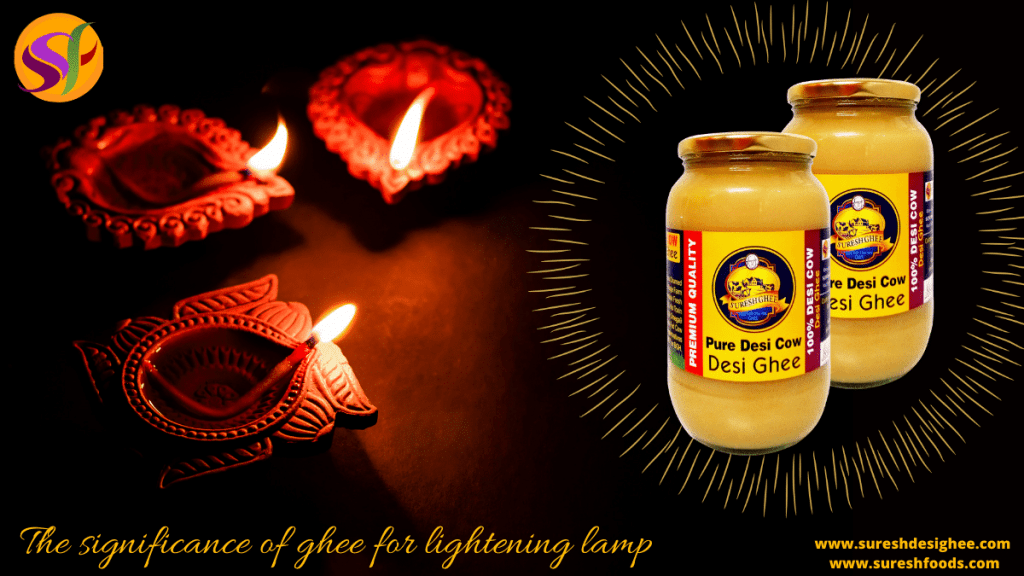
Cow ghee is helpful for lighting lamps in temples and for worship all over India. The ghee used for lightening the lamp enhances the positivity in the atmosphere. Ghee has always been a major ingredient of Indian rituals as one of the popular milk products.
In Indian households, we generally prefer ghee prepared at home with cow milk. Recently a new type of cow ghee has come into the dairy market known as A2 cow ghee. We all know that milk is a vital source of protein.
Ghee is pure fat but it includes a very small proportion of protein as well. There are two categories of protein found in milk named casein and whey. There are also various types of casein protein, one of which is beta-casein. A1 & A2 are two variants of beta-casein that made up 30% of total protein in cow’s milk.
Read More : Why is Desi Ghee preferred over oil for diyas during Pooja?
The Reverence for Ghee in Ayurveda
In Ayurveda, the heartfelt respect for ghee is obtained from the belief that every food substance carries a noticeable energy, classified as Sattvic (peace, purity, love, balance, and harmony), Rajasic (action, movement), or Tamasic (inertia, darkness, dullness).
Ghee is infused with pure or Sattvic energy. Sattvic foods are rich in prana (universal life force), and possess a harmonious and peaceful nature. They assist in physical strength, promote a pure mind, encourage good health, and contribute to longevity, positioning with life’s purpose. Sattvic foods, identified by a sweet taste and nourishing qualities, involve some fresh fruits, fresh vegetables, fresh milk, grains, legumes, nuts, and, of course, ghee.
A Sattvic diet, often renowned as a yogic diet, is seen as a path towards a greater purpose in life. The Sattvic energy present in ghee has historically made it an integral element of religious ceremonies in ancient Vedic customs, where it is offered to “Agni,” the Hindu God of Fire, during rituals. On the contrary, Rajasic foods are stimulating and elevate both physical and mental energy, delivering the drive to fulfill the desires. Although, an excessive dependence on Rajasic foods may result in imbalances and stress. Examples of Rajasic foods involve eggplant, onions, tomatoes, and spices like black tea and coffee.
Tamasic foods activate heaviness and lethargy in the physical, mental, emotional, and spiritual domains. Consuming tamasic foods may lead to dullness and a deficiency in motivation. Examples of tamasic foods cover up canned foods, animal flesh, fried and processed foods, alcohol, and synthetic ingredients.
Ayurveda focuses its attention on a balanced approach, demonstrating a harmonious combination of Sattvic, Rajasic, and Tamasic foods. Gaining equilibrium assures holistic well-being and acknowledges the diverse roles and necessities encountered in life.
Conclusion
Ghee is an incredibly essential ingredient for a healthy body, but it must be pure desi ghee prepared from cow’s milk. Not only does ghee enhance the flavour of food, but also it makes your food into a balanced unit.
Ghee can be a vital source of vitamin A, E, D, and K and it can be useful as medicine for more health issues. Pure desi ghee is helpful to your health as it carries loads of fats that deliver more energy to your system.
A healthy person can intake one to three spoonfuls of ghee per day by avoiding any side effects. To buy pure desi ghee made by the bilona method please visit our website https://sureshfoods.com.

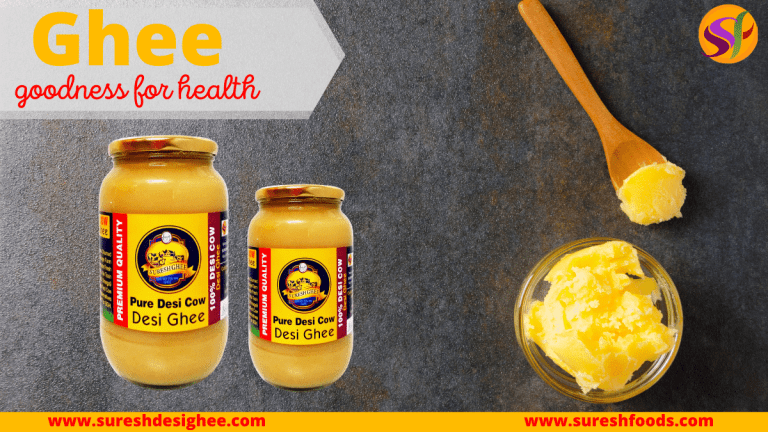


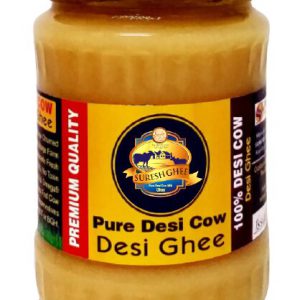
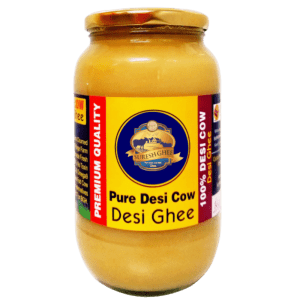
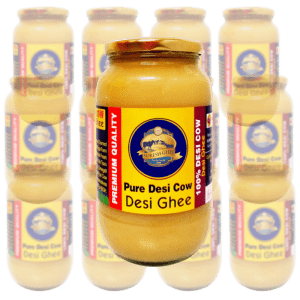
 WhatsApp us
WhatsApp us
Naveen m...